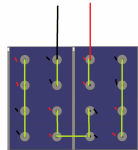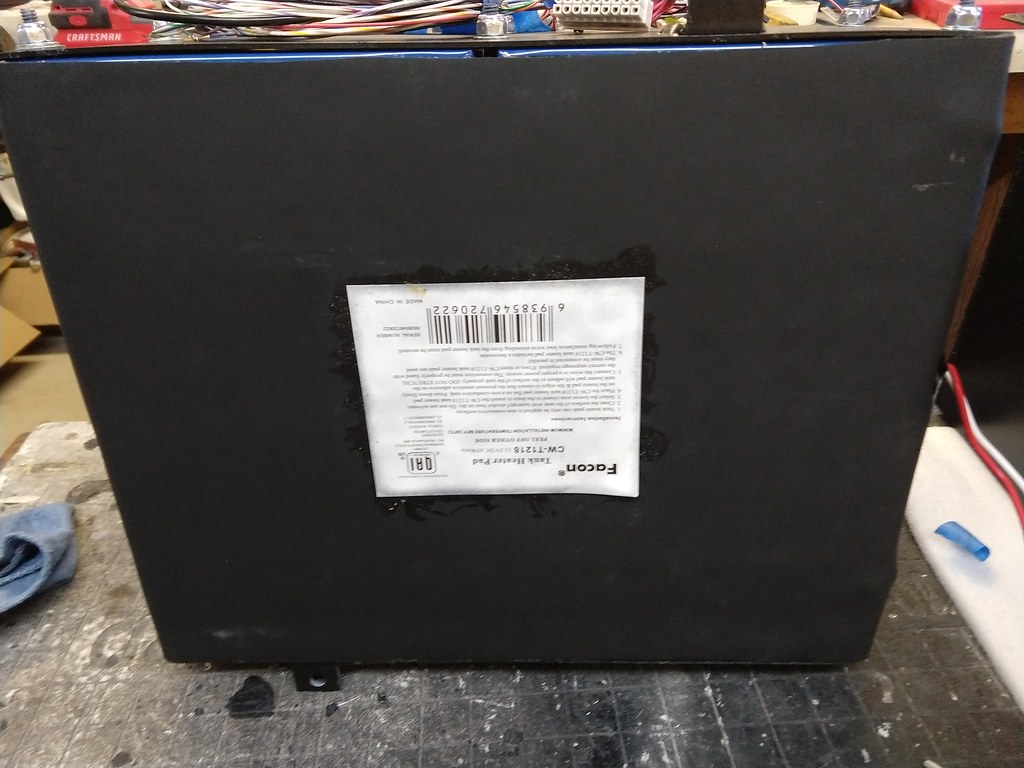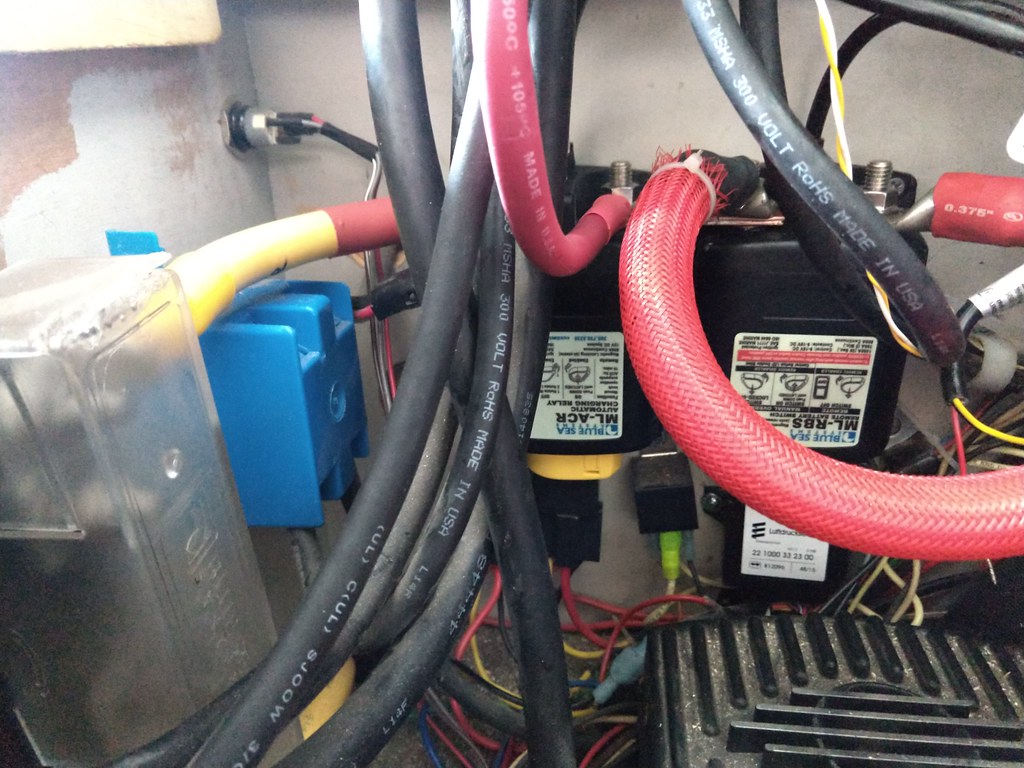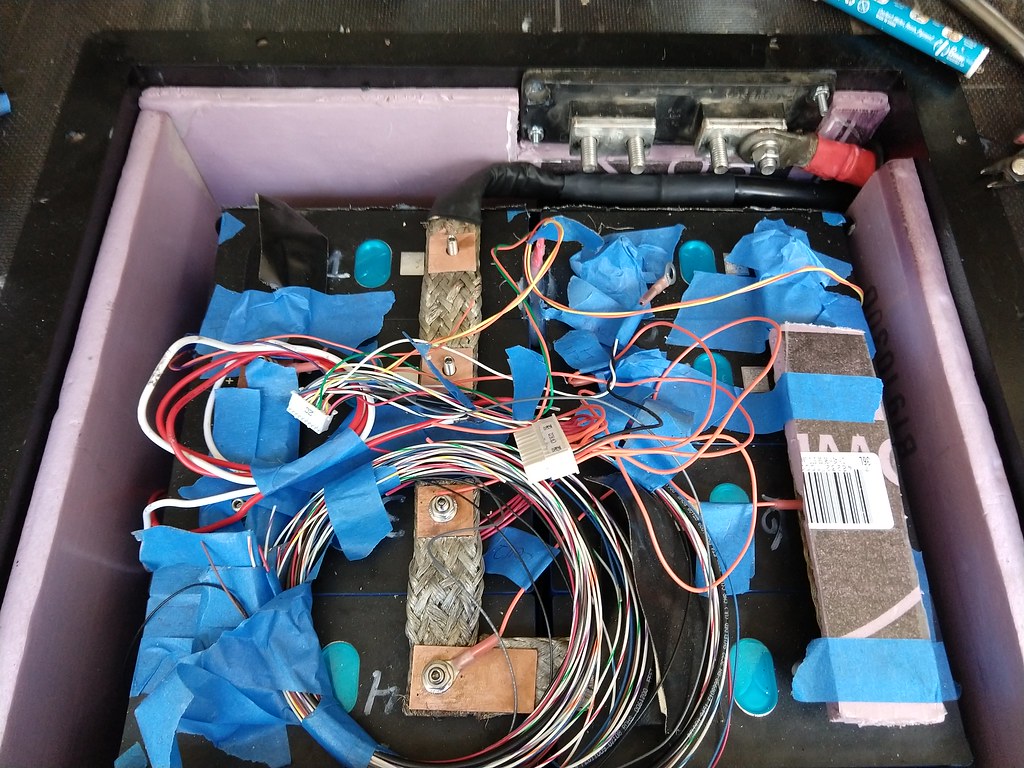luthj
Engineer In Residence
Here is a quick circuit diagram to help work out if limiting current with cable gauge is feasible. This requires a datasheet for the battery in question, or some experimentation.

Since all components in this circuit must have the same current, and all voltage drops and sources must sum to zero.
Valt-Vbat=I*(Rwire+Rbatt)
Any battery can be approximated (for steady state DC) as a voltage source with a resistor. In this example I am using 1mohm, but this will be a fair bit higher with drop-ins. In the circuit above we can see that if Rwire is zero, than the charge current through Rbattery is 13.8-12=I*0.001 I=1,800A. Now, there are a few caveats. First, the alternator cannot supply this much current, so Valt would sag until equilibrium is reached. Second there is always wiring resistance, so Rwire is never zero.
In the case of a 200A alternator in this circuit, that would be Valt-12=200*0.001 Valt=12.2V. Now, the starter battery may contribute a bit of current at 12.2V, which could be 20-50A. So this is a significant simplification for calculations sake.
In order to limit current to say, 100A, then we solve backwards for Rwire.
13.8-12=100*(Rwire + 0.001) Rwire = 0.017 ohm.
Now, what if you don't know Rbattery? Rbattery is a dynamic value which will change with SOC. To determine Rbattery, discharge the pack to the typical minimum SOC. Measure the resting voltage (Vbattery1). Then apply a known charging load, say 20-50A (higher is typically better). Measure Vbattery2 at the terminals.
Rbattery= (Vbattery2-Vbattery1)/I So for example Vbattery1=12V and Vbattery2=12.05V, and current I=100A Rbattery=(12.05-12)/100 = 0.001ohm. Another option is to apply your desired charge load at low SOC, and measure the Vbattery. This loaded voltage can be used with Rbattery to determine Rwire.
Now for a real world example.
Battleborn 100AH batteries have an internal resistance of 6.2mohm.
Assuming Valt of 13.8V and Vbattery of 12V. Note that I chose Vbattery from an estimate. best to measure at the lowest SOC expected. To limit current to 100A is as follows.
Valt-Vbat=I*(Rwire+Rbatt)
13.8-12=100*(Rwire +0.0062) Rwire = 11.8mohm
So to work wiring path. As a rule of thumb every ring terminal connection adds 0.25 mohm, fuses add 1mohm, and relays will add another 0.5 mohm. Maybe 1 for ones under 100A. So in a typical charging circuit you will have say ~8 ring terminals. A relay, and two fuses. So 4-5mohm not counting the cable/wire. So 11.8-4= 7.8mohm. Looking at the table below we see that 6AWG is the minimum wire size based on ampacity. It has .39mohm per foot. So 7.8/.39=20ft. So a 20ft run of 6AWG plus the fuses/relays will result in a ~100A limit. Now its important that the ENTIRE charge circuit is taken into account. This means the engine ground strap, and any other wiring to the battery. If an existing wiring system is installed, the resistance of the components can be measured all together by applying a known load, and measuring the voltage drop. Then using ohms law to work out the resistance.

Since all components in this circuit must have the same current, and all voltage drops and sources must sum to zero.
Valt-Vbat=I*(Rwire+Rbatt)
Any battery can be approximated (for steady state DC) as a voltage source with a resistor. In this example I am using 1mohm, but this will be a fair bit higher with drop-ins. In the circuit above we can see that if Rwire is zero, than the charge current through Rbattery is 13.8-12=I*0.001 I=1,800A. Now, there are a few caveats. First, the alternator cannot supply this much current, so Valt would sag until equilibrium is reached. Second there is always wiring resistance, so Rwire is never zero.
In the case of a 200A alternator in this circuit, that would be Valt-12=200*0.001 Valt=12.2V. Now, the starter battery may contribute a bit of current at 12.2V, which could be 20-50A. So this is a significant simplification for calculations sake.
In order to limit current to say, 100A, then we solve backwards for Rwire.
13.8-12=100*(Rwire + 0.001) Rwire = 0.017 ohm.
Now, what if you don't know Rbattery? Rbattery is a dynamic value which will change with SOC. To determine Rbattery, discharge the pack to the typical minimum SOC. Measure the resting voltage (Vbattery1). Then apply a known charging load, say 20-50A (higher is typically better). Measure Vbattery2 at the terminals.
Rbattery= (Vbattery2-Vbattery1)/I So for example Vbattery1=12V and Vbattery2=12.05V, and current I=100A Rbattery=(12.05-12)/100 = 0.001ohm. Another option is to apply your desired charge load at low SOC, and measure the Vbattery. This loaded voltage can be used with Rbattery to determine Rwire.
Now for a real world example.
Battleborn 100AH batteries have an internal resistance of 6.2mohm.
Assuming Valt of 13.8V and Vbattery of 12V. Note that I chose Vbattery from an estimate. best to measure at the lowest SOC expected. To limit current to 100A is as follows.
Valt-Vbat=I*(Rwire+Rbatt)
13.8-12=100*(Rwire +0.0062) Rwire = 11.8mohm
So to work wiring path. As a rule of thumb every ring terminal connection adds 0.25 mohm, fuses add 1mohm, and relays will add another 0.5 mohm. Maybe 1 for ones under 100A. So in a typical charging circuit you will have say ~8 ring terminals. A relay, and two fuses. So 4-5mohm not counting the cable/wire. So 11.8-4= 7.8mohm. Looking at the table below we see that 6AWG is the minimum wire size based on ampacity. It has .39mohm per foot. So 7.8/.39=20ft. So a 20ft run of 6AWG plus the fuses/relays will result in a ~100A limit. Now its important that the ENTIRE charge circuit is taken into account. This means the engine ground strap, and any other wiring to the battery. If an existing wiring system is installed, the resistance of the components can be measured all together by applying a known load, and measuring the voltage drop. Then using ohms law to work out the resistance.
| AWG wire size (solid) | Area CM* | Resistance per 1000 ft (ohms) @ 20 C | Diameter (inches) | Maximum current** (amperes) |
| 0000 | 211600 | 0.049 | 0.46 | 380 |
| 000 | 167810 | 0.0618 | 0.40965 | 328 |
| 00 | 133080 | 0.078 | 0.3648 | 283 |
| 0 | 105530 | 0.0983 | 0.32485 | 245 |
| 1 | 83694 | 0.124 | 0.2893 | 211 |
| 2 | 66373 | 0.1563 | 0.25763 | 181 |
| 3 | 52634 | 0.197 | 0.22942 | 158 |
| 4 | 41742 | 0.2485 | 0.20431 | 135 |
| 5 | 33102 | 0.3133 | 0.18194 | 118 |
| 6 | 26250 | 0.3951 | 0.16202 | 101 |
| 7 | 20816 | 0.4982 | 0.14428 | 89 |









 IMG_20200818_145757426
IMG_20200818_145757426 IMG_20200818_145802222
IMG_20200818_145802222 IMG_20200818_151602669
IMG_20200818_151602669 IMG_20200819_155032927
IMG_20200819_155032927 IMG_20200819_163811132
IMG_20200819_163811132 IMG_20200820_093839882
IMG_20200820_093839882 IMG_20200820_130332662
IMG_20200820_130332662


